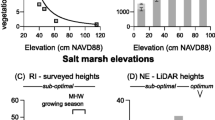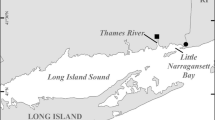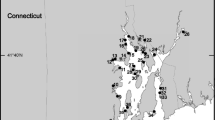Abstract
In southern New England, salt marshes are exceptionally vulnerable to the impacts of accelerated sea level rise. Regional rates of sea level rise have been as much as 50 % greater than the global average over past decades, a more than fourfold increase over late Holocene background values. In addition, coastal development blocks many potential marsh migration routes, and compensatory mechanisms relying on positive feedbacks between inundation and sediment deposition are insufficient to counter inundation increases in extreme low-turbidity tidal waters. Accordingly, multiple lines of evidence suggest that marsh submergence is occurring in southern New England. A combination of monitoring data, field re-surveys, radiometric dating, and analysis of peat composition have established that, beginning in the early and mid-twentieth century, the dominant low-marsh plant, Spartina alterniflora, has encroached upward in tidal marshes, and typical high-marsh plants, including Juncus gerardii and Spartina patens, have declined, providing strong evidence that vegetation changes are being driven, at least in part, by higher water levels. Additionally, aerial and satellite imagery show shoreline retreat, widening and headward extension of channels, and new and expanded interior depressions. Papers in this special section highlight changes in marsh-building processes, patterns of vegetation loss, and shifts in species composition. The final papers turn to strategies for minimizing and coping with marsh loss by managing adaptively and planning for landward marsh migration. It is hoped that this collection offers lessons that will be of use to researchers and managers on coasts where relative sea level is not yet rising as fast as in southern New England.


Similar content being viewed by others
References
Barras, J, S. Beville, D. Britsch, S. Hartley, S. Hawes, J. Johnston, P. Kemp, Q. Kinler, A. Martucci, J. Porthouse, D. Reed, K. Roy, S. Sapkota, and J. Suhayda. 2003. Historical and projected coastal Louisiana land changes: 1978–2050. United States Geological Survey Open File Report 03–334, 39 pp.
Berry, W.J., S.E. Reinert, M.E. Gallagher, S.M. Lussier, and E. Walsh. 2015. Population status of the seaside sparrow in Rhode Island: a 25-year assessment. Northeastern Naturalist 22: 658–671.
Bertness, M.D., C.P. Brisson, M.C. Bevil, and S.M. Crotty. 2014. Herbivory drives the spread of salt marsh die-off. PloS One 9: e92916.
Boon, J.D. 2012. Evidence of sea level acceleration at US and Canadian tide stations, Atlantic Coast, North America. Journal of Coastal Research 28: 1437–1445.
Boothroyd, J.C., N.E. Friedrich, and S.R. McGinn. 1985. Geology of microtidal coastal lagoons: Rhode Island. Marine Geology 63: 35–76.
Bricker-Urso, S., S.W. Nixon, J.K. Cochran, D.J. Hirschberg, and C. Hunt. 1989. Accretion rates and sediment accumulation in Rhode Island salt marshes. Estuaries 12: 300–317.
Britsch, L.D., and J.B. Dunbar. 1993. Land-loss rates: Louisiana coastal plain. Journal of Coastal Research 9: 324–338.
Cahoon, D.R., and G.R. Guntenspergen. 2010. Climate change, sea-level rise, and coastal wetlands. National Wetlands Newsletter 32: 8–12.
Calafat, F.M., and D.P. Chambers. 2013. Quantifying recent acceleration in sea level unrelated to internal climate variability. Geophysical Research Letters 40: 3661–3666.
Cameron Engineering and Associates. 2015. Long Island tidal wetland trends analysis. Prepared for the New England Interstate Water Pollution Control Commission, 207 pp. http://www.dec.ny.gov/lands/5113.html
Carey, J.C., S.B. Moran, R.P. Kelly, A.S. Kolker, and R.W. Fulweiler. This volume. The declining role of organic matter in New England salt marshes. Estuaries and Coasts. doi:10.1007/s12237-015-9971-1.
Carey, J.C., K.B. Raposa, C. Wigand, and R.S. Warren. This volume. Contrasting decadal-scale changes in elevation and vegetation in two Long Island sound salt marshes. Estuaries and Coasts. doi:10.1007/s12237-015-0059-8.
Chapman, V.J. 1960. Salt marshes and salt deserts of the world. New York: Interscience.
Church, J.A., and N.J. White. 2006. A twentieth century acceleration in global sea-level rise. Geophysical Research Letters 33: L01602.
Cole Ekberg, M. K.B. Raposa, W.S. Ferguson, K Ruddock, and E.B. Watson. This volume. Development and application of a salt marsh rapid assessment method to identify vulnerability to sea level rise. Estuaries and coasts.
Deacutis, C.F., D. Murray, W. Prell, E. Saarman, and L. Korhun. 2006. Hypoxia in the upper half of Narragansett Bay, RI, during august 2001 and 2002. Northeastern Naturalist 13: 173–198.
Deegan, L.A., D.S. Johnson, R.S. Warren, B.J. Peterson, J.W. Fleeger, S. Fagherazzi, and W.M. Wollheim. 2012. Coastal eutrophication as a driver of salt marsh loss. Nature 490: 388–392.
Donnelly, J.P. 2006. A revised late Holocene sea-level record for northern Massachusetts, USA. Journal of Coastal Research 22: 1051–1061.
Donnelly, J.P., and M.D. Bertness. 2001. Rapid shoreward encroachment of salt marsh cordgrass in response to accelerated sea-level rise. Proceedings of the National Academy of Sciences 98: 14218–14223.
Donnelly, J.P., P. Cleary, P. Newby, and R. Ettinger. 2004. Coupling instrumental and geological records of sea-level change: evidence from southern New England of an increase in the rate of sea-level rise in the late nineteenth century. Geophysical Research Letters 31: GL018933.
Doran, K. J. 2010. Addressing the problem of land motion at tide gauges, M. S. thesis, College of Marine Science, University of South Florida.
Ezer, T. 2015. Detecting changes in the transport of the Gulf stream and the Atlantic overturning circulation from coastal sea level data: the extreme decline in 2009–2010 and estimated variations for 1935–2012. Global and Planetary Change 129: 23–36.
Fairbanks, R.G. 1989. A 17,000-year glacio-eustatic sea level record: influence of glacial melting rates on the Younger Dryas event and deep-ocean circulation. Nature 342: 637–642.
Field, C.R., C. Gjerdrum, and C.S. Elphick. 2016. Forest resistance to sea-level rise prevents landward migration of tidal marsh. Biological Conservation 201: 363–369.
Frame, G.W., M.K. Mellander, and D.A. Adamo. 2006. Big egg marsh experimental restoration in Jamaica Bay, New York. In People, places, and parks: proceedings of the 2005 George Wright Society conference on parks, protected areas, and cultural sites, ed. D. Harmon, 123–130. Hancock, MI: The George Wright Society.
Goddard, P.B., J. Yin, S.M. Griffies, and S. Zhang. 2015. An extreme event of sea-level rise along the northeast coast of North America in 2009–2010. Nature Communications 6: NCOMM6346.
Hartig, E.K., V. Gornitz, A. Kolker, F. Mushacke, and David Fallon. 2002. Anthropogenic and climate-change impacts on salt marshes of Jamaica Bay, New York City. Wetlands 22: 71–89.
Jacobson, H.A., G.L. Jacobson Jr., and J.T. Kelley. 1987. Distribution and abundance of tidal marshes along the coast of Maine. Estuaries 10: 126–131.
Kearney, M.S., A.S. Rogers, J.R.G. Townshend, E. Rizzo, D. Stutzer, J. Stevenson, and K. Sundberg. 2002. Landsat imagery shows decline of coastal marshes in Chesapeake and Delaware Bays. EOS. Transactions American Geophysical Union 83: 173–178.
Keene, H.W. 1971. Postglacial submergence and salt marsh evolution in New Hampshire. Maritime Sediments 7: 64–68.
Kelley, J.T., D.F. Belknap, G.L. Jacobson Jr., and H.A. Jacobson. 1988. The morphology and origin of salt marshes along the glaciated coastline of Maine, USA. Journal of Coastal Research 4: 649–666.
Kemp, A.C., B.P. Horton, J.P. Donnelly, M.E. Mann, M. Vermeer, and S. Rahmstorf. 2011. Climate related sea-level variations over the past two millennia. Proceedings of the National Academy of Sciences 108: 11017–11022.
Kennish, M.J. 2001. Coastal salt marsh systems in the US: a review of anthropogenic impacts. Journal of Coastal Research 17: 731–748.
Kirwan, M.L., and G.R. Guntenspergen. 2015. Response of plant productivity to experimental flooding in a stable and submerging marsh. Ecosystems 18: 903–913.
Kirwan, M.L., A.B. Murray, J.P. Donnelly, and D. Reide Corbett. 2011. Rapid wetland expansion during European settlement and its implication for marsh survival under modern sediment delivery rates. Geology 39: 507–510.
Kopp, R.E., A.C. Kemp, K. Bittermann, B.P. Horton, J.P. Donnelly, W.R. Gehrels, C.C. Hay, J.X. Mitrovica, E.D. Morrow, and S. Rahmstorf. 2016. Temperature-driven global sea-level variability in the common era. Proceedings of the National Academy of Sciences 113: E1434–E1441.
Kreeger, D., J. Moody, M. Katkowski, M. Boatright and D. Rosencrance. 2015. Marsh futures: use of scientific survey tools to assess local salt marsh vulnerability and chart best management practices and interventions. Partnership for the Delaware Estuary, Wilmington, DE. PDE Report No. 15–03.
Mengel, M., A. Levermann, K. Frieler, A. Robinson, B. Marzeion, and R. Winkelmann. 2016. Future sea level rise constrained by observations and long-term commitment. Proceedings of the National Academy of Sciences 113: 2597–2602.
Miller, W.R., and F.E. Egler. 1950. Vegetation of the Wequetequock-Pawcatuck tidal marshes, Connecticut. Ecological Monographs 20: 143–172.
Morris, J.T., P.V. Sundareshwar, C.T. Nietch, B. Kjerfve, and D.R. Cahoon. 2002. Response of coastal wetlands to rising sea level. Ecology 83: 2869–2877.
Morris, J.T., D.C. Barber, J.C. Callaway, R. Chanbers, S.C. Hagen, C.S. Hopkinson, B.J. Johnson, P. Megonigal, S.C. Neubauer, T. Troxler, and C. Wigand. 2016. Contributions of organic and inorganic matter to sediment volume and accretion in tidal wetlands at steady state. Earth’s Future 4: 110–121.
Mudge, B.F. 1858. The salt marsh formations of Lynn. Proceedings Essex Institute, 1856–1860. Salem, MA, USA, 2: 117–119.
National Oceanic and Atmospheric Administration (NOAA). 2015. Tides and currents products. http://tidesandcurrents.noaa.gov/products.html Accessed 5 June 2015.
Niering, W.A., and R.S. Warren. 1974. Tidal wetlands of Connecticut: volume 1, vegetation and associated animal populations. Hartford, CT: Department of Environmental Protection, State of Connecticut.
Niering, W.A., and R.S. Warren. 1980. Vegetation patterns and processes in New England salt marshes. Bioscience 30: 301–307.
Nixon, S.W. 1982. The ecology of New England high salt marshes: a community profile. No. FWS/OBS-81/55. Washington DC and Kingston, RI: National Coastal Ecosystems Team, and Graduate School of Oceanography, University of Rhode Island.
Orson, R., W. Panageotou, and S.P. Leatherman. 1985. Response of tidal salt marshes of the U.S. Atlantic and gulf coasts to rising sea levels. Journal of Coastal Research 1: 29–37.
Orson, R.A., R.S. Warren, and W.A. Niering. 1987. Development of a tidal marsh in a New England river valley. Estuaries 10: 20–27.
Passeri, D.L., S.C. Hagen, S.C. Medeiros, M.V. Bilskie, K. Alizad, and D. Wang. 2015. The dynamic effects of sea level rise on low-gradient coastal landscapes: a review. Earth’s Future 3: 159–181. doi:10.1002/2015EF000298.
Pasternack, G.B., G.S. Brush, and W.B. Hilgartner. 2001. Impact of historic land-use change on sediment delivery to a Chesapeake Bay subestuarine delta. Earth Surface Processes and Landforms 26: 409–427.
Raposa, K.B., R.L. Weber, M. Cole Ekberg, W. Ferguson. This volume. Vegetation dynamics in Rhode Island salt marshes during a period of accelerating sea level rise and extreme sea level events. Estuaries and Coasts.
Raposa, K.B., M.L. Cole Ekberg, D.M. Burdick, N.T. Ernst, and S.C. Adamowicz. 2016. Elevation change and the vulnerability of Rhode Island (USA) salt marshes to sea-level rise. Regional Environmental Change. doi:10.1007/s10113-016-1020-5.
Redfield, A.C. 1972. Development of a New England salt marsh. Ecological Monographs 42: 201–237.
Redfield, A.C., and M. Rubin. 1962. The age of salt marsh peat and its relation to recent changes in sea-level at Barnstable, Massachusetts. Proceedings of the National Academy of Sciences (USA) 48: 1728–1735.
Roman, C.T., N. Jaworski, F.T. Short, S. Findlay, and R.S. Warren. 2000. Estuaries of the northeastern United States: habitat and land use signatures. Estuaries 23: 743–764.
Sallenger, A.H., K.S. Doran, and P.A. Howd. 2012. Hotspot of accelerated sea-level rise on the Atlantic coast of North America. Nature Climate Change 2: 884–888.
Smith, S.M. 2009. Multi-decadal changes in salt marshes of Cape Cod, MA: photographic analyses of vegetation loss, species shifts, and geomorphic change. Northeastern Naturalist 16: 183–208.
Smith, J.A. 2013. The role of Phragmites australis in mediating inland salt marsh migration in a mid-Atlantic estuary. PloS One 8: e65091.
Smith, S.M. 2015. Vegetation change in salt marshes of Cape Cod National Seashore (Massachusetts, USA) between 1984 and 2013. Wetlands 35: 127–136.
Smith, S.M., K.C. Medeiros, and M.C. Tyrrell. 2012. Hydrology, herbivory, and the decline of Spartina patens (Aiton) Muhl. In outer Cape Cod salt marshes (Massachusetts, USA. Journal of Coastal Research 28: 602–612.
Spada, G., M. Olivieri, and G. Galassi. 2015. A heuristic evaluation of long-term global sea level acceleration. Geophysical Research Letters 42: GL063837.
Steever, E.Z., R.S. Warren, and W.A. Niering. 1976. Tidal energy subsidy and standing crop production of Spartina alterniflora on Connecticut salt marshes. Estuarine and Coastal Marine Science 4: 473–478.
Stevenson, J.C., M.S. Kearney, and E.C. Pendleton. 1985. Sedimentation and erosion in a Chesapeake Bay brackish marsh system. Marine Geology 67: 213–235.
Sweet, W.V., and C. Zervas. 2011. Cool-season sea level anomalies and storm surges along the US East Coast: climatology and comparison with the 2009/10 El Niño. Monthly Weather Review 139: 2290–2299.
Tiner, R.W., K. McGuckin, and J. Herman. 2014. Rhode Island wetlands: updated inventory, characterization, and landscape-level functional assessment, 63 pp. Northeast region, Hadley, MA: U.S. Fish and Wildlife Service.
Torio, D.D., and G.L. Chmura. 2013. Assessing coastal squeeze of tidal wetlands. Journal of Coastal Research 29: 1049–1061.
Trocki, C.L. 2003. Patterns of salt marsh and farmland use by wading birds in southern Rhode Island. Ph.D. dissertation, University of Rhode Island.
Turner, R.E. 2009. Doubt and the values of an ignorance-based world view for restoration: coastal Louisiana wetlands. Estuaries and Coasts 32: 1054–1068.
Van Dyke, E., and K. Wasson. 2005. Historical ecology of a central California estuary: 150 years of habitat change. Estuaries 28: 173–189.
Voss, C.M., R.R. Christian, and J.T. Morris. 2013. Marsh macrophyte responses to inundation anticipate impacts of sea-level rise and indicate ongoing drowning of North Carolina marshes. Marine Biology 160: 181–194.
Warren, R.S., and W.A. Niering. 1993. Vegetation change on a northeast tidal marsh: interaction of sea-level rise and marsh accretion. Ecology 74: 96–103.
Wasson, K., B. Suarez, A. Akhavan, E. McCarthy, J. Kildow, K.S. Johnson, M.C. Fountain, A. Woolfolk, M. Silberstein, L. Pendleton, and D. Feliz. 2015. Lessons learned from an ecosystem-based management approach to restoration of a California estuary. Marine Policy 58: 60–70.
Watson, E.B. 2004. Changes in elevation, accretion, and tidal marsh plant assemblages in a South San Francisco Bay tidal marsh. Estuaries 27: 684–698.
Watson, E.B., C. Wigand, E. W. Davey, H.M. Andrews, and J. Bishop. This volume. Wetland loss patterns and inundation-productivity relationships prognosticate widespread salt marsh loss for southern New England. Estuaries and Coasts
Watson, E.B., A.J. Oczkowski, C. Wigand, A.R. Hanson, E.W. Davey, S.C. Crosby, R.L. Johnson, and H.M. Andrews. 2014. Nutrient enrichment and precipitation changes do not enhance resiliency of salt marshes to sea level rise in the northeastern US. Climatic Change 125: 501–509.
Watson, E.B., C. Wigand, M. Cencer, and K. Blount. 2015. Inundation and precipitation effects on growth and flowering of the high marsh species Juncus gerardii. Aquatic Botany 121: 52–56.
Watson, E.B., K. Szura, C. Wigand, K.B. Raposa, K. Blount, and M. Cencer. 2016. Sea level rise, drought and the decline of Spartina patens in New England marshes. Biological Conservation 196: 173–181.
West, J. 2014. What’s going on with our salt marshes? And why should we care? Narragansett Bay. Journal 28: 1–3.
Weston, N.B. 2014. Declining sediments and rising seas: an unfortunate convergence for tidal wetlands. Estuaries and Coasts 37: 1–23.
Wigand, C., C.T. Roman, E. Davey, M. Stolt, R. Johnson, A. Hanson, E.B. Watson, S.B. Moran, D.R. Cahoon, J.C. Lynch, and P. Rafferty. 2014. Below the disappearing marshes of an urban estuary: historic nitrogen trends and soil structure. Ecological Applications 24: 633–649.
Wigand, C., T. Ardito, C. Chaffee, W. Ferguson, S. Paton, K. Raposa, C. Vandemoer, and E.B. Watson. This volume. A climate change adaptation strategy for management of coastal marsh systems. Estuaries and Coasts.
Yin, J., M.E. Schlesinger, and R.J. Stouffer. 2009. Model projections of rapid sea-level rise on the northeast coast of the United States. Nature Geoscience 2: 262–266.
Acknowledgments
Special section authors gratefully acknowledge Estuaries and Coasts editorial staff for helping us get the word out on such an important and timely global—and local—issue. We appreciate the cooperation of the Narragansett Bay National Estuarine Research Reserve (NBNERR), Save The Bay, the Rhode Island Coastal Resources Management Council, and the US Environmental Protection Agency as the inter-agency partnership that organized the workshop. In addition, we thank C. Chaffee, M. Cole Ekberg, and W. Ferguson for contributing the observations that helped spawn these research activities and J. West, W. Berry, and the staff of the NBNERR for facilitating the workshop that resulted in this set of manuscripts being published as a joint work. This report, ORD Tracking Number ORD-016293, has been reviewed technically by the US EPA’s Office of Research and Development, National Health and Environmental Effects Research Laboratory, Atlantic Ecology Division, Narragansett, RI, and approved for publication. Approval does not signify that the contents necessarily reflect the views and policies of the US EPA.
Author information
Authors and Affiliations
Corresponding author
Additional information
Communicated by Carolyn A. Currin
Rights and permissions
About this article
Cite this article
Watson, E.B., Raposa, K.B., Carey, J.C. et al. Anthropocene Survival of Southern New England’s Salt Marshes. Estuaries and Coasts 40, 617–625 (2017). https://doi.org/10.1007/s12237-016-0166-1
Received:
Revised:
Accepted:
Published:
Issue Date:
DOI: https://doi.org/10.1007/s12237-016-0166-1




